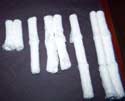Alternative Hygienic Aid Protects Incisions
February 1, 2008
R&D DIGEST
|
Made from commercially available materials, the absorbent pad can shield postsurgical incisions from debris. |
After facing few comfortable options to treat a cesarean section infection, a stay-at-home mother from Utah developed a hygienic aid that can both help prevent infections and accelerate healing. The JIBS, which stands for the initials of the inventor's children, is a product that protects the incision made during a cesarean section. It shields the site from outside debris and keeps it free of irritation and moisture buildup.
The inventor, Denise Howland, used off-the-shelf materials to make the prototype and is hoping that a medical device company will have interest in manufacturing and marketing the device. She says the JIBS should also be fairly inexpensive to manufacture on a large scale.
Howland has undergone four cesarean sections and has firsthand experience with the complications of the procedure. After surgery, moisture forms in between the skin that hangs over the incision, which can cause an infection. JIBS, which is made of cotton and rayon fibers with a rayon overwrap, is placed under the flap of skin to keep the area dry. If an infection is present, the product keeps anything from entering the area, allowing the wound to heal faster.
Available in three different sizes, the current prototype is free of dyes and doesn't require glue or adhesives. Since it's made of a cotton-rayon blend, it bends to the contour of the body. Howland says it's better than gauze or large bandages. Gauze pads tend to be thin and irritating, and can't absorb excessive moisture.
“This is solid, so it can soak up a lot of wetness,” says Howland. “[You can] wear it half of the day and change it. An adhesive bandage sticks to the body and hurts when it comes off. This doesn't stick to the body at all. It stays there to keep [the area] dry.”
The skin fold keeps the device in place and absorbs any moisture or sweat that is created in between the folds. “It doesn't smell, itch, or irritate the skin,” says Howland. “You're numb there anyway, so you don't know it's there.” Her doctor was impressed with the product, because it could provide an option for women who need to keep the incision area dry.
The product can also be used on obese patients to prevent skin irritation, rashes, and open sores, and for patients who undergo a hysterectomy.
Howland has had assistance from InventHelp, a Pittsburgh-based inventor service company, in conducting research on the product's target population. The company can be contacted for more information on licensing or selling the product to device manufacturers.
Copyright ©2008 Medical Device & Diagnostic Industry
About the Author(s)
You May Also Like



